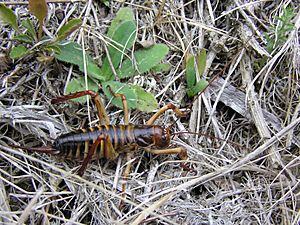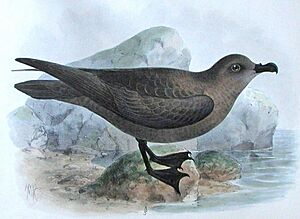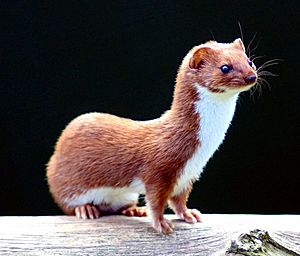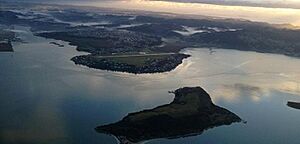Motu Matakohe facts for kids
|
Matakohe (Māori)
Nickname: Limestone Island
|
|
|---|---|
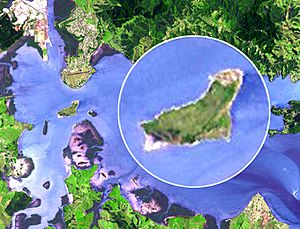
The island from above
|
|
| Geography | |
| Location | Whangarei Harbour, Pacific Ocean |
| Coordinates | 35°47′3″S 174°21′34″E / 35.78417°S 174.35944°E |
| Area | 0.37 km2 (0.14 sq mi) |
| Administration | |
|
New Zealand
|
|
| Northland | |
| Demographics | |
| Population | 1 (island ranger) |
| Pop. density | 0 /km2 (0 /sq mi) |
Motu Matakohe, also known as Matakohe or Limestone Island, is a small island in New Zealand. It covers about 37 hectares (100 acres). You can find it in the upper part of Whangarei Harbour. The island is close to Onerahi, a coastal town near the city of Whangarei in the Northland Region.
For many years, people used the island for farming and industry. But now, it's a great example of how a group of volunteers can help bring nature back. They have worked hard to restore the island's natural environment.
Island History: From Māori to Modern Day
The first people known to live on Motu Matakohe were the Ngaitahuhu Māori. They lived there in the early 1700s. Later, in the mid-1700s, another Māori group called Ngāpuhi, led by Te Ponaharakeke, took over the area.
Early European Settlement and Industry
In 1832, the first European house was built on the island, but it was later destroyed. In 1848, two men, Robert Carruth and Mathew Whitelaw, leased the island from the Parawhau hapū (a Māori sub-tribe). They started a limeworks there, using the island's natural limestone.
In 1865, Henry Walton bought the island from Te Tirarau and other Parawahau chiefs. The limeworks grew bigger, and sheep were also farmed on the island. By 1881, the first batch of Portland cement was made there. The limeworks became a very important local business. At its busiest, in the early 1900s, it employed 270 people!
Changes and Conservation Efforts
Later, the Northland Harbour Board bought the island. They used it as pasture (land for grazing animals) for many decades. In 1989, the island was given to the Whangarei District. This is when the first steps to protect and restore the island began.
Bringing Nature Back: Ecological Restoration
Today, the Friends of Matakohe-Limestone Island Society (FOMLI) manages the island. This group was officially formed in 1991. In 1996, David Wright became the Resident Ranger, looking after the island.
In 1999, the island was officially named a scenic reserve. A floating dock was built to make it easier for people to visit. The restoration work has involved planting huge numbers of native plants. They have also brought back animals that had disappeared from the island and the nearby mainland.
Invertebrates: Tiny Island Dwellers
Invertebrates are animals without backbones. Some of these tiny creatures have been brought to the island from the mainland. These include wētā and stick insects. They also tried to reintroduce flax snails, but this hasn't worked yet. It's exciting that adult wētā have been found far from where they were first released!
Reptiles: Lizards on the Island
Different types of lizards have been brought back to the island, or there are plans to do so. Some of these lizards are becoming rare on the mainland. In 2001, two young forest geckos were released, but they haven't been seen since. However, shore skinks and ornate skinks have been successfully introduced. The island is also a good place for tuatara, which are unique reptiles found only in New Zealand.
Kiwi: A Safe Place to Grow
Since 2001, North Island brown kiwi have been brought to the island. The island is a safe place for them because there are almost no predators. This is part of the Department of Conservation's "Operation Nest Egg" program. Kiwi chicks are released on the island to grow. They stay there for 12–18 months until they weigh about 1 kilogram (2.2 pounds) or more. At this size, they can defend themselves from most predators. Then, they are released back to the mainland. Between 2004 and 2007, 47 kiwi chicks "graduated" from the island and returned home.
Grey-faced Petrel: Returning to Nest
From 2004 to 2008, young grey-faced petrels were moved to the island. The goal was to start a new group of these birds there. Chicks were taken from their nests on Taranga (Hen Island) before they could fly. They were then moved to special artificial nests on Matakohe. Here, they were fed until they were old enough to fledge (fly for the first time) and leave the island. Over five years, 152 chicks successfully flew away. These chicks were banded (given a small ring on their leg). It is hoped that the first birds will start coming back to Matakohe three to five years after they left. They will look for places to nest and find partners. Petrels might not start breeding until they are seven years old.
Controlling Pests: Protecting Island Wildlife
Animals that are not native to the island and can harm local wildlife are called exotic predators. These include possums, cats, rats, and mustelids (like stoats and weasels). All of these have been removed from Motu Matakohe.
However, because the mainland is close and animals can sometimes cross the mudflats at low tide, rats, stoats, and weasels still visit the island sometimes. Mice have not been completely removed yet, but efforts continue. Their numbers are kept low using poison bait stations.



